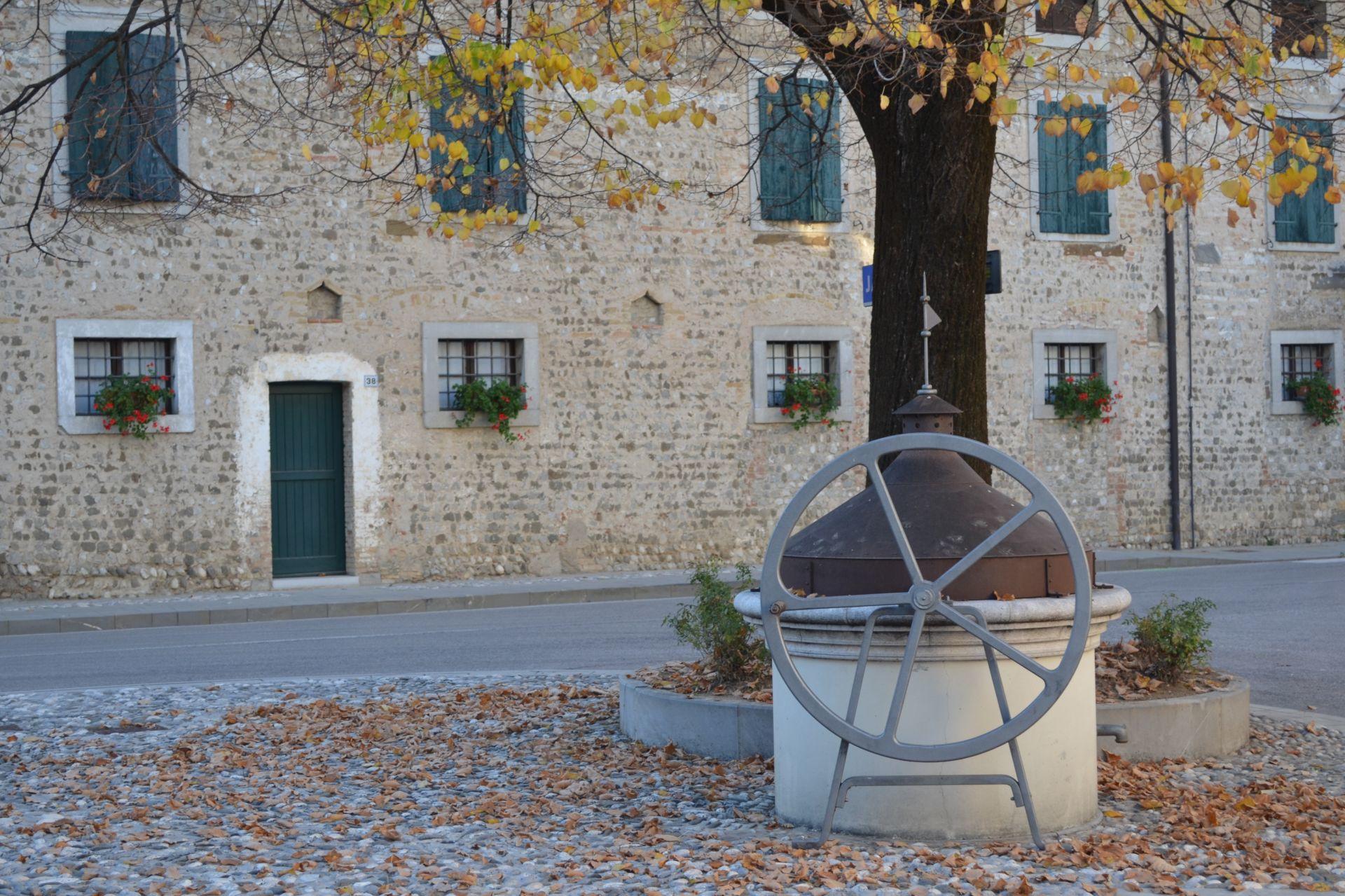The village
"Mamma li turchi!!!" That piercing cry that united many Friulian villages set ablaze in 1477 certainly echoed in Clauiano, razed to the ground by Saracen hordes. Then came the reconstruction. Rewarding. The new urban structure indeed eliminated any solutions found to be weak or risky during the Ottoman raid and the various barbarian invasions that afflicted the area throughout the entire Middle Ages and up to the 15th century. Gradually, a fascinating village of "piéris e clàps," "stones and rocks," took shape. The buildings were constructed in masonry with tiles on the roof, tightly packed together in true defensive curtains, developed around the two churches of San Giorgio, to the south, and San Martino, to the north. The village expanded, resuming the industrious life that had made it a reference center. Not by chance, since the Middle Ages, meetings were held in the church of San Giorgio to make decisions on internal matters, but also on those of neighboring villages. Among the first masonry houses were Casa Gardellini with an L-shaped structure attached to other 16th-century buildings that are part of Casa Beltramini with the typical well-defended internal courtyard, and Casa Tonutti Campagnolo where a 15th-century fresco depicting a Madonna with Child between two Saints has been preserved. In the 17th century, Clauiano experienced an important phase of development during which the two nuclei located to the north and south of the village ended up merging so that from the following century the village took on its current form. Many parts of the courtyard complex of Casa Colussi, Dri, and Minin, Casa Palladini Piani with the typical hearth, the "fogolâr," with the large hood that develops over the next two floors and ends with an elegant chimney of Venetian shapes, and the three-story palace of the noble Porta family with an attached gardener's house, stable, prison, and "foledôr," that is, the wine cellar usually built near the main body of the residence, date back to this period. From the 18th century is Villa Ariis with the round-arched portal topped by a double window with a stone balustrade and the adjacent, notable, "foledôr," Villa Manin Guerresco with a facade embellished with pilasters and an upper tympanum, and Casa Zof Piano which, according to the elders, was originally a convent and is characterized by a lowered stone arch portal.

From the same period, but of more ancient origins, are Casa Barnaba Manin, Casa Calligaris Foffani, and Casa Bosco. The current church of San Giorgio Martire, located on the main street of the village, also dates back to the first half of the 18th century and chose a sober Baroque style, maintained for both interiors and exteriors. The building, with a much older history dating back to the Lombard era, houses a 16th-century baptismal font attributed to Carlo da Corona, a canvas by Osvaldo Gortanutti from 1690 depicting the Adoration of the Magi, and an 18th-century banner used for processions. Incidentally, the other church around which Clauiano developed, also from the Lombard period and dedicated to San Martino, was demolished in 1954. In the mid-19th century, Clauiano reached its peak development, and important families like the Manin, Mattioli, de Checo, Bassi, Bearzi, and De Vit built homes with large rustic buildings. They were the ones who gave a boost to the village's economy by building a spinning mill, given the presence of numerous mulberry rows in the area, whose leaves were the food for silkworms. Today, the inhabitants of Clauiano show attention to their history by paving the streets with piasentina stone or pebbles from the nearby Torre stream, replanting those mulberries that the area was rich in and that were an excellent source of sustenance until a few decades ago, enhancing the area in front of the church of San Giorgio, restoring the exposed walls of the houses, the ancient frescoes and paintings, the sundials, the loggias, and the numerous entrance arches to the houses. An example of the same care is the uncovering of the design of the old pond in the square. There, rainwater was collected to water the animals and wash clothes. Today, the blue of the water has been replaced with the green of the grass, maintaining the sincere rural flavor of the village. The rural church of San Marco. Archaeological findings indicate a small construction already in the Roman period. The building is from the 14th century, with frescoed interiors, an apsidal basin in stone, a masonry step functioning as a bench all around the walls, and a 16th-century altar, a legacy of restorations following the passage of the Turks.
The Name The toponym "Clauiano," unlike many others, is of immediate interpretation: it dates back to the Roman era and refers to the name of the owner of a significant estate in the area of the current village, called Claudius or Clavilius, from Clavius.
Municipality of Trivignano Udinese Borgo di Clauiano
Province of Udine
Patron Saint
S. Marco, 25 aprile
Distances in km
Gorizia 30, Udine 20, Palmanova 4, Aquileia 20
Inhabitants
1,700 (500 in the village)
Altitude
13 m a.s.l.
Area
18.46 km2
Coordinates
45°51'N 12°53'E
Tourist Information
Town Hall
tel. 0432 999002 – 0432 999038 – fax 0432 999559
Municipal Library
0432 999002 ext. 116
Tuesday 10.00 -12.30 / Thursday 10.30-11.30 – 16.30-18.30 / Friday 11.00 -12.00
Palmanova Tourist Information and Reception Office
tel. and fax 0432 924815
Things to know
-
Municipality of Trivignano Udinese Borgo di Clauiano
Province of Udine
-
Patron Saint
S. Marco, 25 aprile
-
Distances in km
Gorizia 30, Udine 20, Palmanova 4, Aquileia 20
-
Inhabitants
1,700 (500 in the village)
-
Altitude
13 m a.s.l.
-
Area
18.46 km2
-
Coordinates
45°51'N 12°53'E
Tourist Information
-
Town Hall
tel. 0432 999002 – 0432 999038 – fax 0432 999559
-
Municipal Library
0432 999002 ext. 116
Tuesday 10.00 -12.30 / Thursday 10.30-11.30 – 16.30-18.30 / Friday 11.00 -12.00
-
Palmanova Tourist Information and Reception Office
tel. and fax 0432 924815












 Clauiano
Clauiano